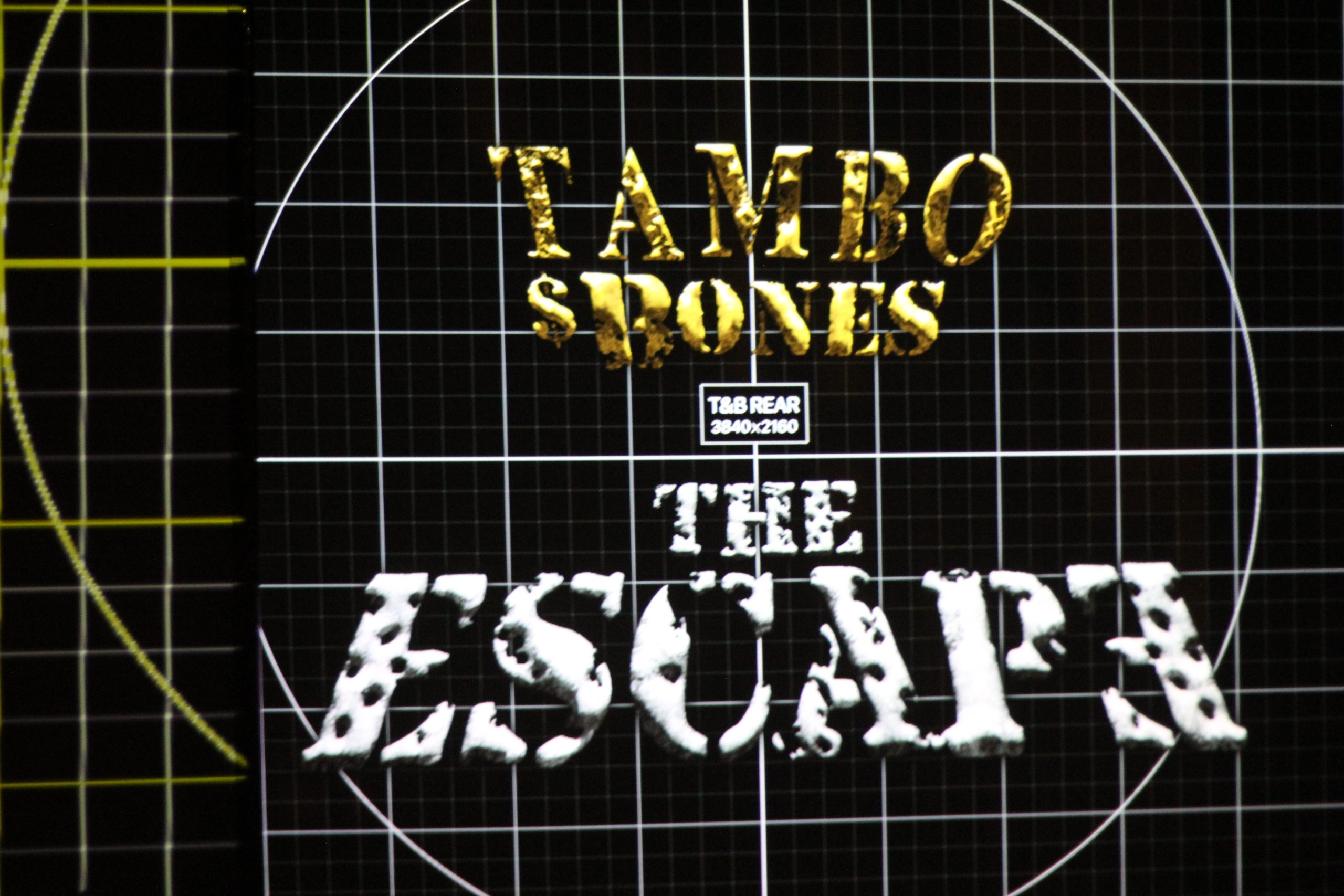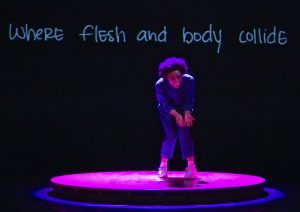
Tambo and Bones have the potential to become your next favorite rap duo, just watch! Tambo and Bones written by Philly playwright Dave Harris, is a play and rap concert que hace uso de dark humor and lots of wit to highlight the complexities and horrors of making it on your own terms as a Black performer in the United States. Tambo and Bones starts with the two main characters quickly realizing they are stuck in a minstrel show, but who put them there and how do they break free? Tambo played by William Anthony Sebastian Rose II, and Bones played by Patrick Newson Jr., take their audience on an expedition through time and space as they grapple with the tension between capitalism and racism in America’s past, present, and future.
Eme Ospina-López, is a queer and trans video artist from Bogotá, Colombia, and the creative mind behind the projections in Tambo and Bones. Join me in getting to know more about Eme’s origin story and journey into the world of theater and projection design!
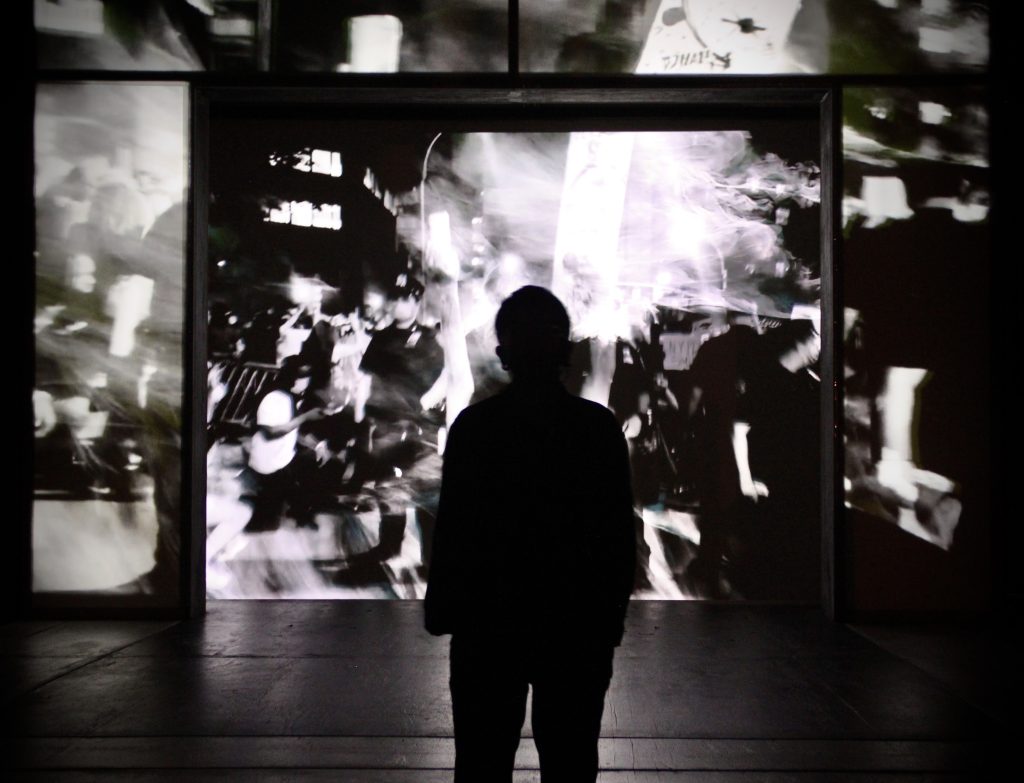
Sidoni Gonzalez: Cuéntame un poquito de ti.
Eme Ospina-López: Bueno. Yo soy de Bogotá, Colombia. Nací y crecí en Bogotá y viví ahí hasta hace cuatro años. Bueno, yo soy hije de profe; crecí con la influencia intelectual de mi mamá, que navegaba espacios educativos, administrativos y culturales, atravesados por la complicada realidad de mi país. En mi casa aprendí de la importancia de conocer y hablar de esas realidades políticas y materiales con conciencia social y fui inspirade por la posibilidad de ser artista como respuesta a las condiciones de mi entorno. Entonces cuando decidí estudiar diseño y a los seis meses cuando decidí estudiar arte al mismo tiempo, siempre se sintió como un proyecto de vida válido y que daba continuidad al carácter de la formación reflexiva que recibí. Ese origen definitivamente siempre ha influenciado my approach to design, on any médium.
SG: Was projection design what you studied in undergrad?
EOL: No, projections design came later. Yo estudié con beca en la Universidad de Los Andes. Es una universidad privada y la más cara en Colombia, en el centro de Bogotá, rodeada por barrios que experimentan gentrificación por la presencia de la institución, históricamente habitados por realidades ajenas a las de la mayoría de estudiantes. Estudiar en Los Andes, implicó para mí cuestionar la burbuja de privilegio que rodea una educación económicamente inaccesible y los efectos sociales del pensamiento generado en un espacio donde prevalece el elitismo, en un país donde la desigualdad es tan profunda. The School is walking-distance from La Plaza de Bolívar, punto de encuentro del poder del pueblo, de manifestaciones y protestas, parte de la identidad y cultura social de mi ciudad. Ahí fue donde, como una persona queer en sus early twenties, empecé a buscar y construir comunidad, donde conocí amigues que inspiraron mi libertad. Beyond, outside the university, the most important time of my undergrad I spent with collectives, on the streets and in conversations, aprendiendo sobre las tensiones entre la academia y las redes de base comunitaria, aprendiendo sobre las complejidades de contar historias ajenas.
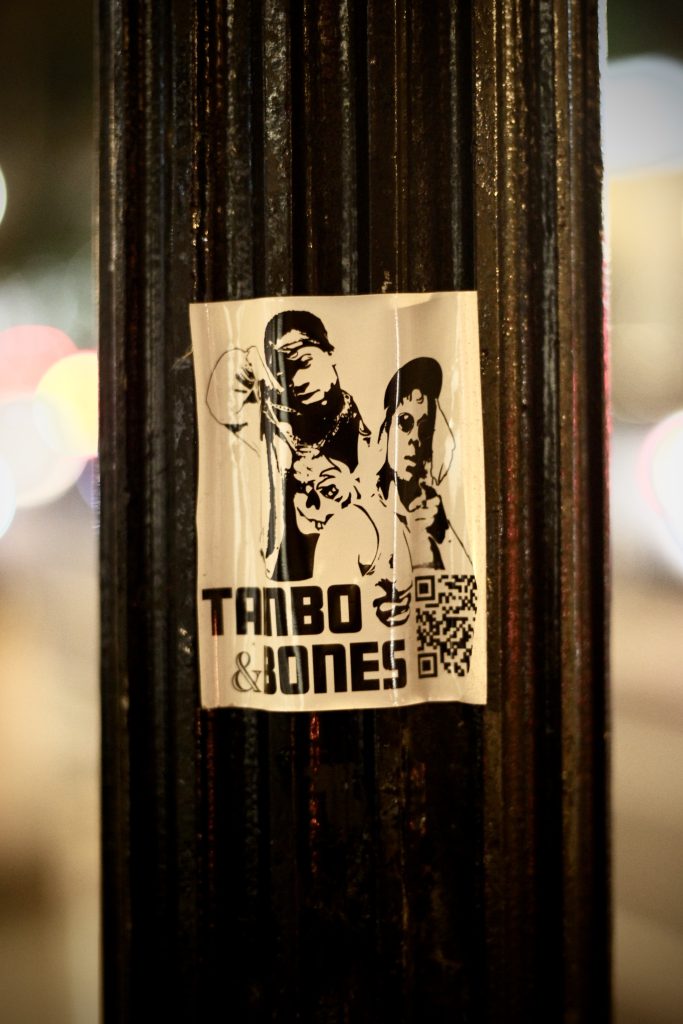
“The most important time of my undergrad I spent with collectives, on the streets and in conversations, aprendiendo sobre las tensiones entre la academia y las redes de base comunitaria, aprendiendo sobre las complejidades de contar historias ajenas.”
SG: ¿Usaste el diseño como una herramienta cuando estabas organizando?
EOL: Las skills que estaba aprendiendo era lo que tenía para ofrecer y cómo pude entender mi rol en ese momento. It was like, okay, I’m learning these tools de diseño de comunicación, gráficas y audiovisuales, I’m learning cómo documentar emociones y acciones a través de procesos artísticos, tengo que poner eso en función de todas estas cosas que tienen que cambiar. Y esas experiencias me enseñaron muchos valores que llevo conmigo como storyteller.
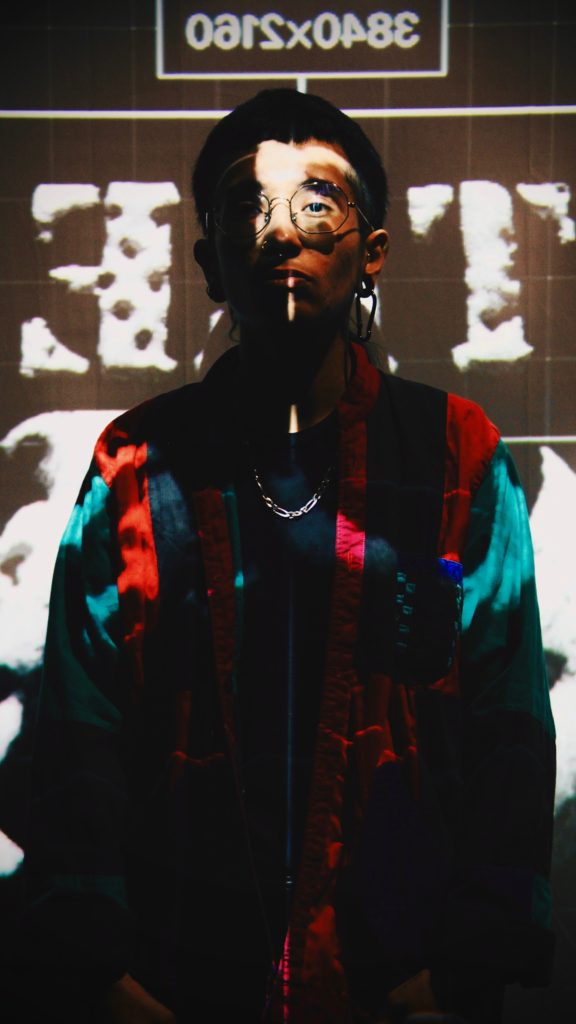
SG: ¿Entonces fue en ese tiempo cuando empezaste a diseñar proyecciones?
EOL: El teatro me pasó por coincidencia. Estaba en una clase de animación y se dio la oportunidad de diseñar entre todes animaciones que sirvieran para una pantalla LED que haría parte del diseño de escenografía de una ópera que se iba a presentar gratis y al aire libre en el festival “Ópera al Parque”. La ópera era “La Flauta Mágica” de Mozart, pero fue clave para mí que era una versión en español y para toda la familia. Me interesó mucho el potencial de esa propuesta. Al final del proceso preguntaron “bueno, ¿quién quiere venir a correr el show?” Y yo no tenía ni idea de qué iba a tener que hacer, pero levanté la mano. Esa fue mi primera vez y lo que más recuerdo fue la adrenalina, la emoción de percibir el disfrute de la gente, la satisfacción de la experiencia colectiva de las artes vivas. How I see it, lo que atraviesa de manera muy clara y determinante el activismo y la producción teatral es la colaboración, el compromiso de construir con otres. El mundo que queremos no lo construyes tú solx.
SG: Can you talk about some of the primary responsibilities of a projection designer?
EOL: Algo que me apasiona mucho de este rol es que, para mí, siempre está cambiando y depende del proyecto. Ok, podemos empezar por decir que una de las funciones principales de todes quienes participan en estos procesos de colaboración -no solo diseñadores, directores, performers- es construir una visión, una visión que refleja profunda colectividad y una interpretación de una realidad (pasada, presente o futura). A veces el texto o el proceso le indica al projections designer la necesidad de contextualizar el lugar y el tiempo, una función posible con relación a la escenografía. Pero, así como otros elementos de diseño, también puede ser más una forma de inmersión en los flujos de emociones y tensiones, de cambio, de los elementos de transformación que hay en la narrativa y en los personajes. Muchas veces, media/projections can make o manifest the layers and concepts that exist in another time of the story, o que son intangibles, o que emergen de la interpretación particular del equipo que la produce y hacen una puesta en escena, una experiencia única.
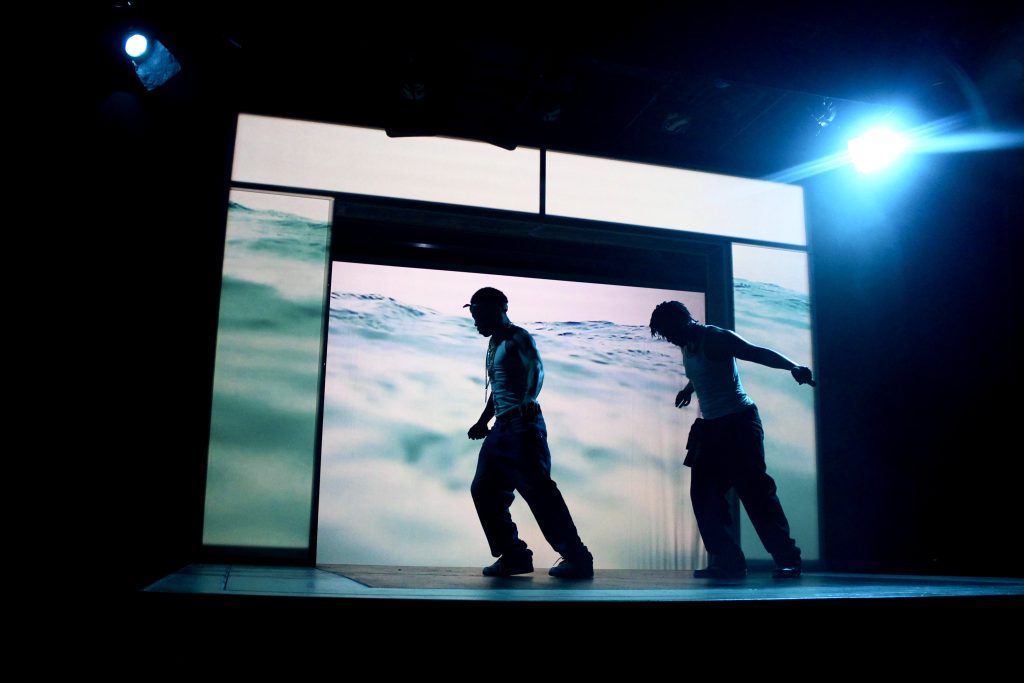
SG: Can you share your experience with Tambo and Bones? Walk us through the collaboration and creative process and how much creative freedom you had?
EOL: I joined the creative team of Tambo and Bones responding to a post on the Chicago Theatre Jobs site. I was called to interview with the Artistic Directors of Refracted Theatre Co, Tova Wolff and Graham Miller, and the director of the show, Michael Burke. From the first conversation it felt very exciting to potentially collaborate. A couple of hours after I heard about the offer, I accepted, and shortly after I had a first creative meeting with Michael. Usually, during this first chat with a director, you learn how horizontal the process may be, how much artistic freedom you’ll have, how much you are going to be heard about how you interpret what you’re reading and what you can to bring to the collaboration table. In this case, from the beginning Michael assured appreciation for my perspective and interest in my personal style. He shared how he understood the text and the world of the play in terms of tensions and dichotomies. We spoke about what this fabrication could look like, how self-aware it is and how it mutates through the arc of the play.
SG: Did you design for all three parts?
EOL: Projections are included only in part two of the play. I think that also speaks to the role elements of design can play and what that medium can do for the work as a whole.
SG: Was that choice made by the director?
EOL: It was an agreement.
SG: Cool, so you were part of that conversation?
EOL: Definitely! I would say that I was part of all the conversations that I felt like I had to be part of. We discussed ideas of what could be happening in part one and three in terms of projections. But it was as a team that we identified that while in part two they are essential, there were other strategies and design elements that would create the impact we were looking for in parts one and three.
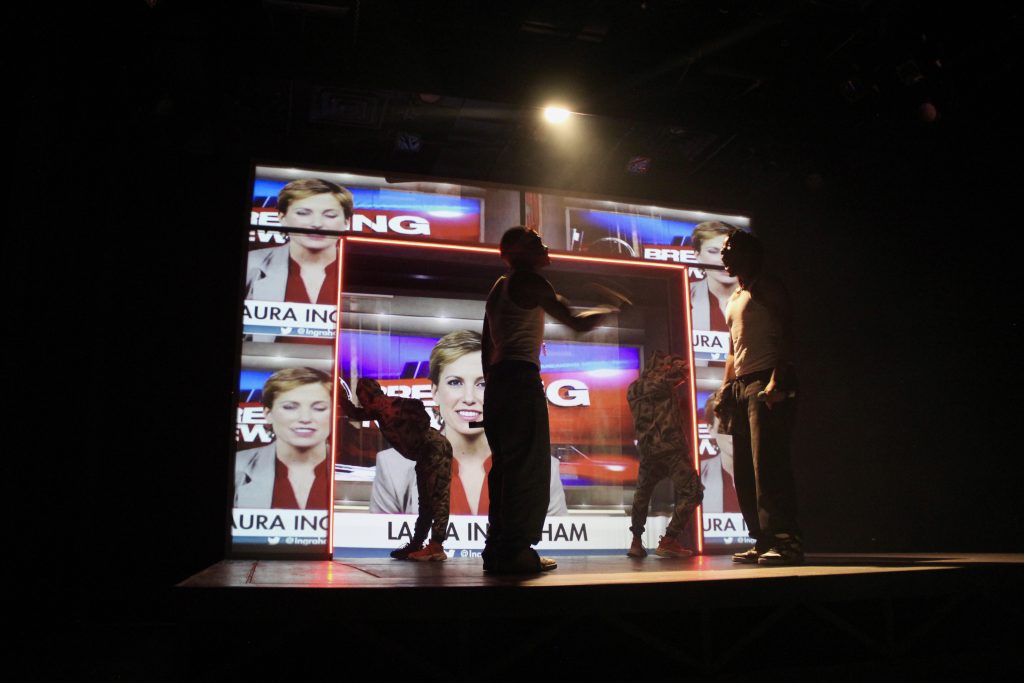
SG: For part two in Tambo and Bones, which includes a whole concert experience, what was the process like creating and choosing the footage for each of the songs?
EOL: First it’s really about going into the process of living in the play with a creative mind, not just like a reader but a creator that is going to build on the text and start to imagine it as an experience. Those ideas came together from conversations I had with Michael . We talked about how each song felt and how the energy shifts throughout the concert because there are definitely not just songs happening, right? There’s a narrative that is telling us how and what got them on that stage, plus the bigger theme of what to do with a platform, how that’s defined by their own identity as real people beyond the performance. We see how Tambo and Bones’s characters change, how Tambo wants to use his voice and the clash with Bones wanting to make profit. We see the tensions between different understandings of getting and having power. As far as projections, where they live and how they become one with the set, there was always a conversation with the scenic designer, Sydney Lynn, who incorporated my ideas into the epic transformation from minstrel show to rap concert. We wanted it to be multi-layered and dynamic, to have different depths and feel like the most real artificial rap concert possible.
SG: Did you draw inspiration from specific hip-hop artists or eras in hip-hop?
EOL: In the script, Dave Harris, the playwright, gives you clues and a base on stylistically how the songs should sound like referring to artists and eras of hip-hop. Composed early in the process by Ethan Korvne, each song has a different melody and instrumentation that reference a different moment in the genre. I had music to work with in addition to the work of Kenya Ann Hall, the dramaturg, who put together a whole bunch of resources that were very useful to place each track in the landscape of hip-hop and the broader cultural one. This was key for me taking into consideration that I come from a place and culture where hip-hop has had a different presence than it does in the States. For example, the first song is called “Started From the Cotton” and it has a 70’s, Kool & The Gang vibe. Because of the lyrics, I also drew inspiration from Ossie Davis’s documentary Black Shadows on a Silver Screen, that through the history of Black filmmakers between 1900-1950 speaks of the portrayal of Black people as they saw themselves as opposed to how they were represented by white media. I used that as a reference of why and how I wanted to incorporate historical footage throughout the concert. Another example is “War”, for which Michael had a strong connection with Kendrick Lamar’s performances and became a source of inspiration for designing part two.
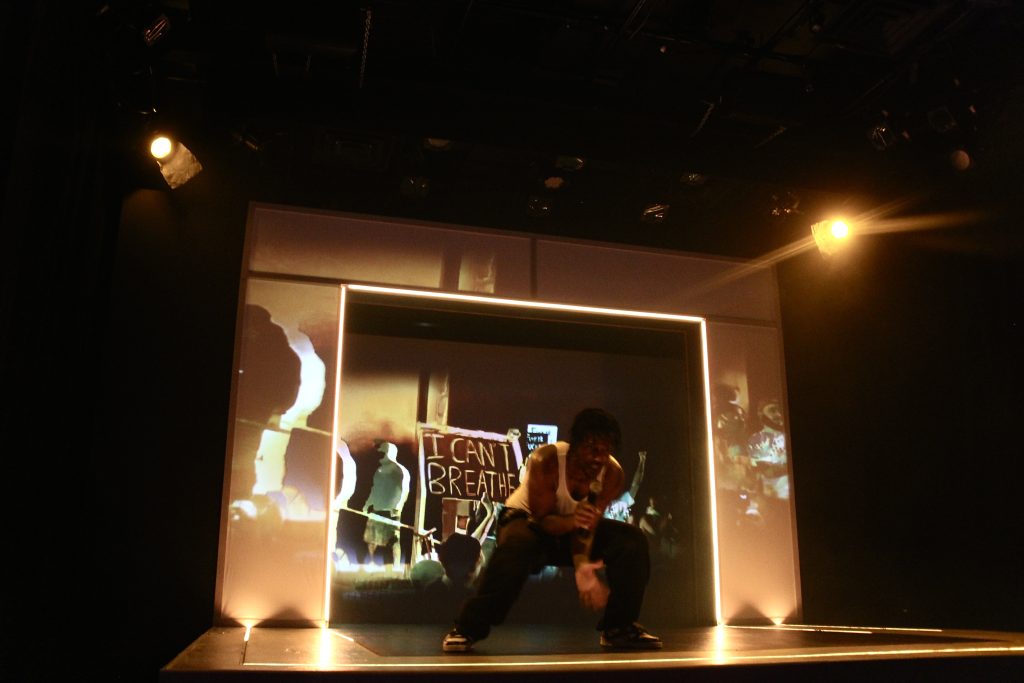
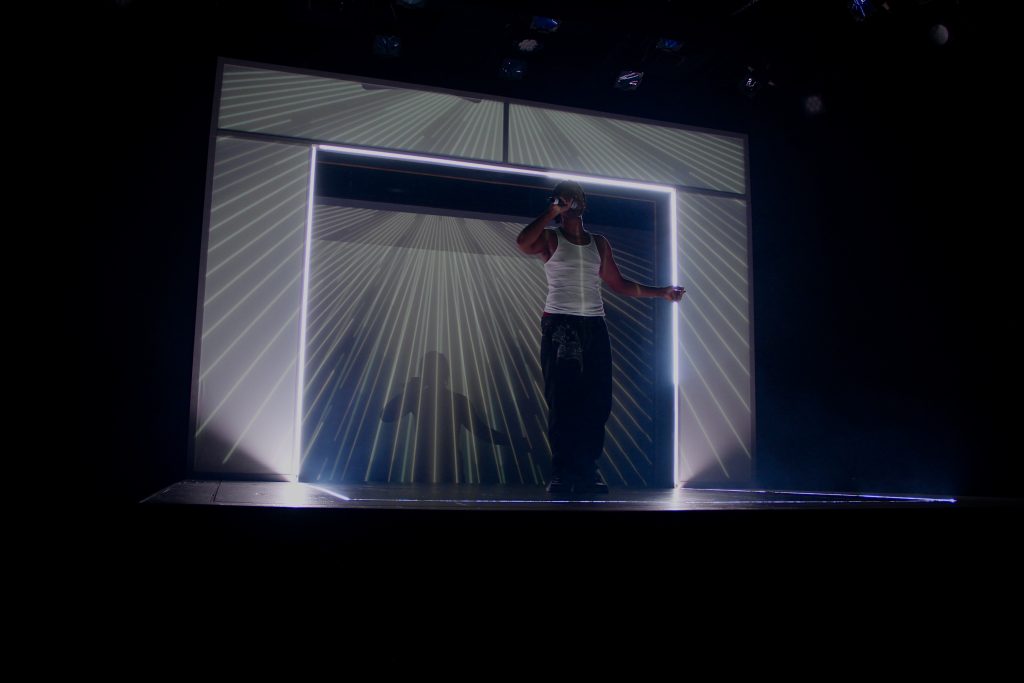
SG: For the second song “Bootstrapping” you use footage of Tambo and Bones out in the world, did you shoot that footage?
EOL: Yes. Depending on what the production is, we designers don’t always work closely with actors. Tambo and Bones gave me a chance to work with the cast and to get to know them as people too. For me it was important that this concert was the story of these two characters and living their fantasy. Getting to interact with the actors in these different layers of human interaction was a very key part of the creative process that I think comes through really strongly in that second part.
SG: Going back to the song “War” there’s a moment when Bones comes back out on stage and interrupts Tambo by saying something along the lines of, “this is too real, this audience is here to have a good time.” Bones is in his own way also calling out to the audience’s participation in creating this exploitative ecosystem. That back and forth tension is highlighted throughout the entire play.
EOL: I think that back and forth you are talking about is also enhanced by the visual universes I created for each song. For songs about money and making it, I used primarily stock footage. From first glance you can feel that it’s fake and highly produced because who has access to Lamborghinis, all that cash, yachts, etc? In comparison, the footage I used of protests and rallies, those images are all over social media, I have my own archive too, and those images evoke a very different feeling.
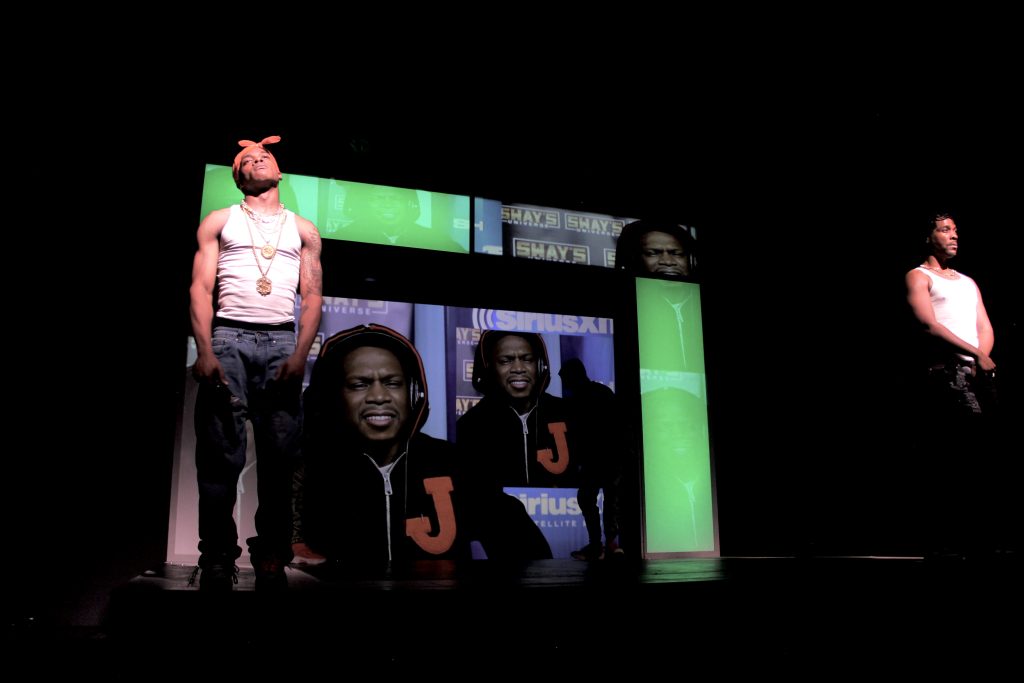
SG: Have you designed projections for concerts before?
EOL: Yes, for Cimarrón at “El Festival Internacional del Joropo” in 2019 en Villavicencio, Colombia. Cimarrón is a joropo ensemble, folkloric dance and music from the llanos in Colombia and Venezuela.
SG: How cool! And finally, do you have any advice for QTBIPOC designers trying to break into the industry?
EOL: I’d say look for work that you’re passionate about, inspired by, and that you’re challenged by as an artist and as a person. Look for spaces and creative environments where you can bring your whole authentic self with questions and provocations and originality to the table. This is an industry like any other where there are many obstacles, especially for BIPOC designers, writers, performers. I’m very interested in companies that want to do new work by indigenous, black and brown people, people from different diasporas, queer and trans people. And so that’s the content I’m pursuing and looking forward to working on.
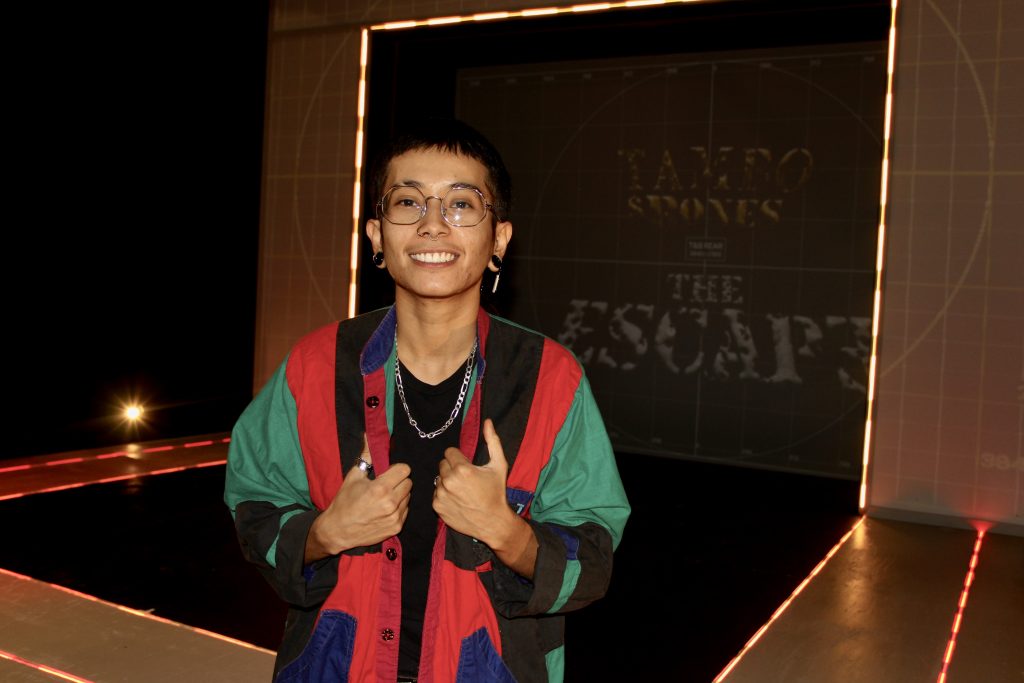
“See something that sounds disruptive of the traditional stories and ways of making? Invest and get involved!”
In Chicago, there is an important presence of Black and Latinx companies, QT people that are self-producing their shows in different formats. I trust a powerful way of breaking in the scene is by connecting directly with projects you want to collaborate with, that are trying to create emerging spaces for people that have not always been welcomed and appreciated in the industry. Despite there being a lot of talk of change in the cultural ecosystem, a big part of creating that change is betting on your people by supporting every time you see somebody is working to start something new. See something that sounds disruptive of the traditional stories and ways of making? Invest and get involved!
Check out Tambo and Bones now playing now through November 11th at The Den Theatre:
https://www.refractedco.com/tambo-bones
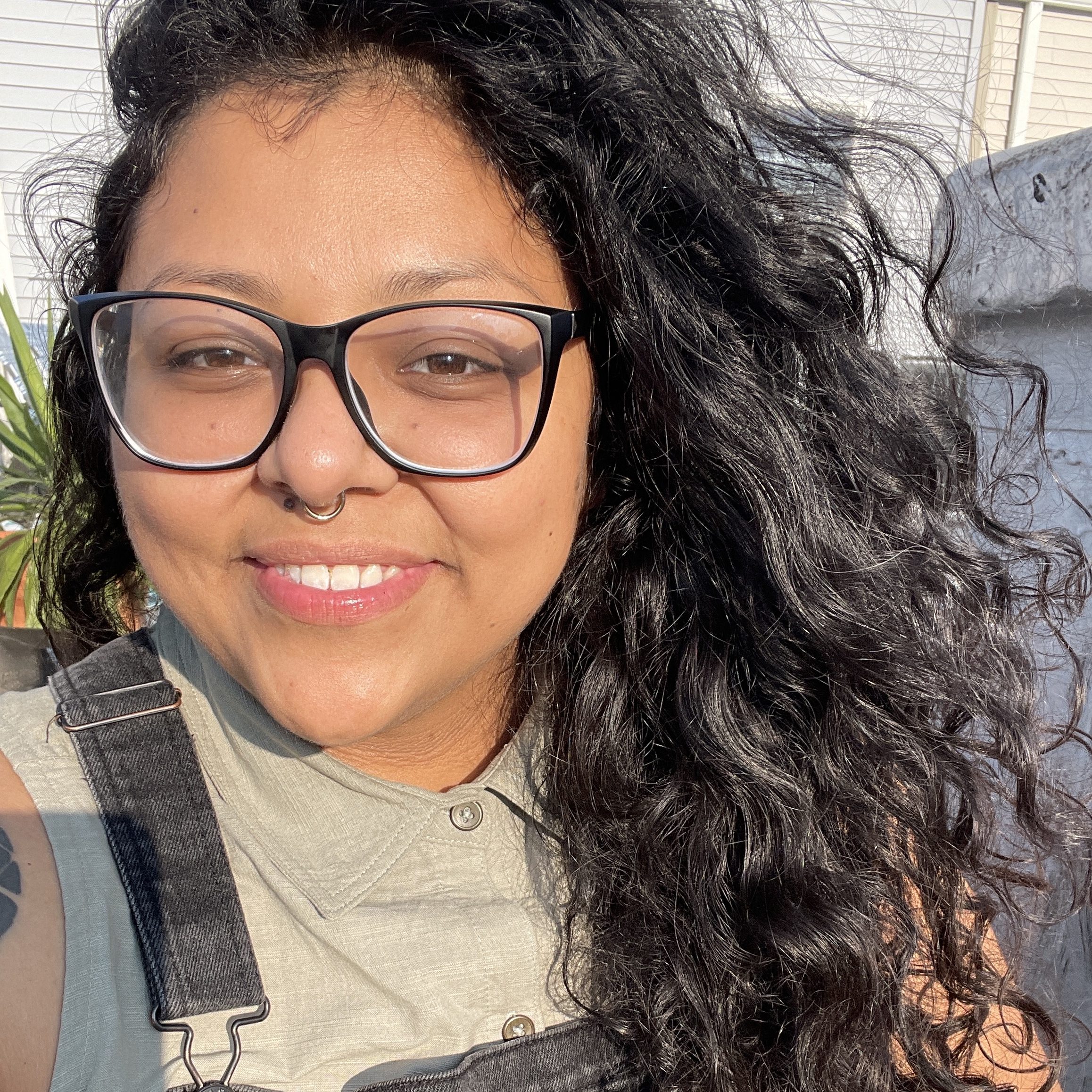
About the author: Sidoni Gonzalez is an interdisciplinary artist, organizer and pleasure activist. Tough and tender, born on Counsel of the Three Fires (aka Chicago) and raised in the streets of Pilsen, Sidoni specializes in curating pleasure-based music and art events and producing short films. Their multimedia visual art delves into self-pleasures, desire, shadow work, and tapping into ancestral energy to heal lineages. Sidoni loves to spend time surrounded by trees and flowy waters, gathering inspiration to create worlds where queer and trans people of color can exist and express their joy without shame or fear.
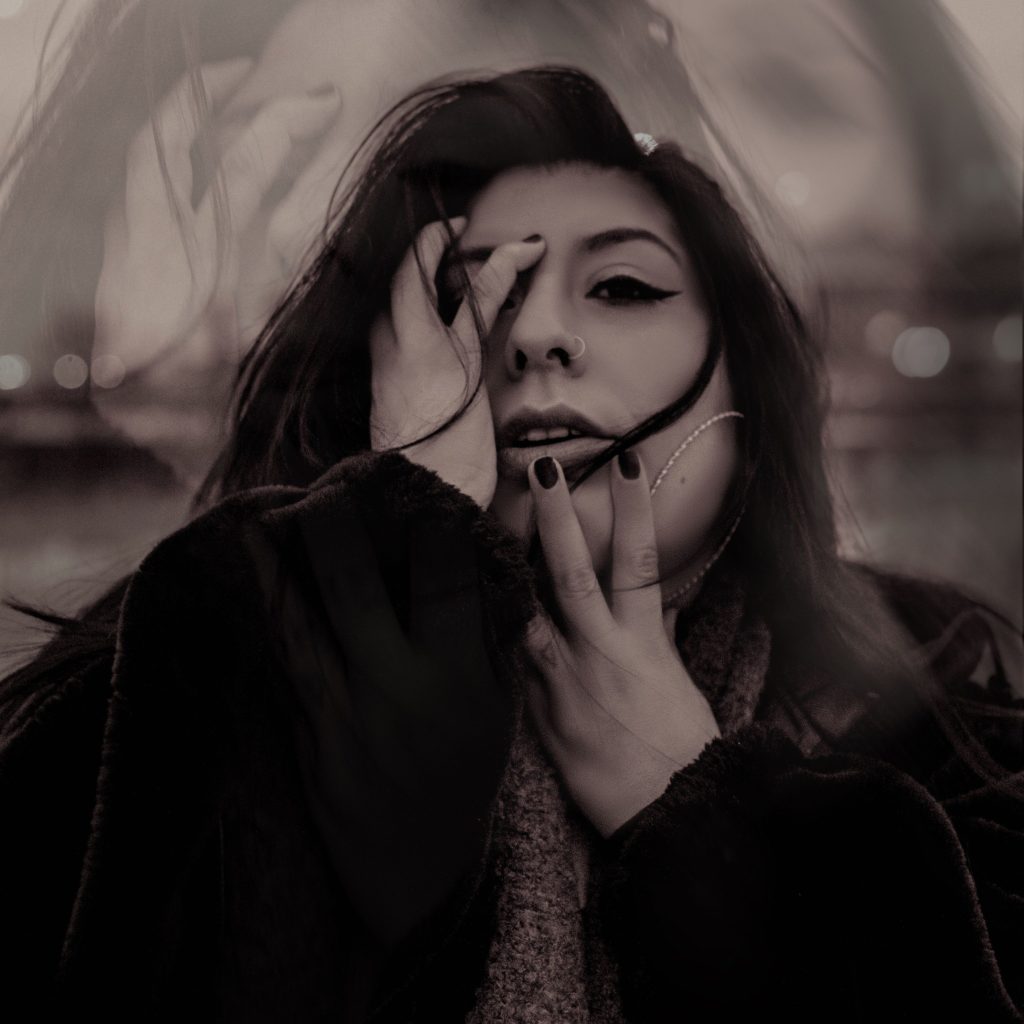
About the photographer: Luz Magdaleno Flores is Sixty’s Bilingual Editor. She is a Chicana art curator, poet, textile artist, and fotógrafa based in Pilsen by way of Oxnard, California, also known as DJ Light of Your Vida. As a content creator and layout designer she has published La Pera Chapbook, Bajito & Suavecito Foto Zine, Cultura Mexicana en Pilsen y La Villita Chicago (winner of the first place photo book 2016 at Roosevelt University), ¿SERIO? Zine, and edited the last six Brown and Proud Press Anthologies. Her words have been featured on the Chicago Reader, South Side Weekly, Canada’s Broken Pencil Magazine, Xicanation.com, and Reverb LP. @lightofyourvida
